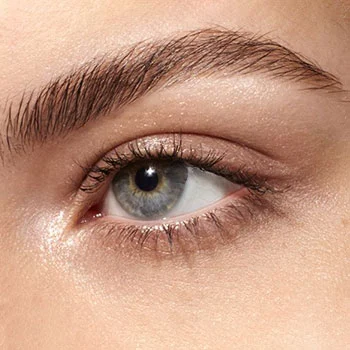What is an Eyelash Transplant?
Eyelash transplant is a surgical procedure that involves the transplantation of hair follicles from other parts of the body, typically the back of the scalp, to the eyelid area. It is performed to enhance the length, thickness, and density of eyelashes for individuals with sparse or absent lashes due to various reasons, such as genetics, trauma, or medical conditions.
During the procedure, a small strip of hair-bearing skin or individual hair follicles are harvested from the donor area and carefully transplanted into tiny incisions made along the eyelid margin. The transplanted hair follicles then grow and produce new eyelashes over time. The procedure is typically performed under local anesthesia on an outpatient basis.
Eyelash transplant surgery requires precision and expertise to ensure natural-looking results and minimize the risk of complications. The transplanted eyelashes will require regular trimming and maintenance similar to natural eyelashes.
Who are the Candidates For the Procedure?
Candidates for eyelash transplants are individuals who have sparse or absent eyelashes and desire to enhance the length, thickness, and density of their lashes. Here are some common reasons why someone may be considered a candidate for an eyelash transplant:
- Genetic Factors: Some individuals are born with naturally thin or sparse eyelashes due to genetic factors. They may seek an eyelash transplant to achieve fuller and more prominent lashes.
- Trauma or Injury: Accidents, burns, or other traumatic events can cause permanent damage to the eyelashes, leading to their loss or thinning. An eyelash transplant can be an option for those who have experienced eyelash loss due to such incidents.
- Medical Conditions: Certain medical conditions, such as alopecia areata, trichotillomania (hair-pulling disorder), or chemotherapy-induced hair loss, can result in the loss or thinning of eyelashes. Eyelash transplant may be considered for individuals with these conditions who desire restored eyelash growth.
- Cosmetic Enhancement: Some individuals simply desire longer, thicker, or more dramatic eyelashes for cosmetic reasons. They may opt for eyelash transplants to achieve their desired aesthetic appearance.
It is important to consult with a qualified and experienced surgeon who specializes in eyelash transplantation to determine if you are a suitable candidate. The surgeon will evaluate factors such as the density of your donor hair, the condition of your eyelids, and any underlying medical conditions to determine if an eyelash transplant is a viable option for you. They will provide personalized recommendations and discuss the potential risks and benefits of the procedure based on your individual circumstances.
What to Expect Before the Procedure?
Before undergoing an eyelash transplant procedure, there are several things you can expect. Here is an overview of what typically happens before the procedure:
- Consultation: You will have an initial consultation with a qualified surgeon who specializes in eyelash transplants. During this consultation, you will discuss your goals and expectations, medical history, any underlying conditions, and the suitability of the procedure for you. The surgeon will examine your eyelashes, assess the donor hair availability, and explain the procedure in detail.
- Preoperative Instructions: Prior to the procedure, your surgeon will provide you with specific preoperative instructions. These instructions may include guidelines on medications to avoid, dietary restrictions, and any necessary preparations, such as washing your face and eyelids thoroughly.
- Medical Evaluation: Depending on your overall health and medical history, your surgeon may request a medical evaluation to ensure that you are in good condition to undergo the procedure. This may involve blood tests, EKG, or other diagnostic tests as deemed necessary.
- Consent and Discussion: You will be provided with informed consent forms to review and sign. These forms outline the potential risks, benefits, and possible complications associated with the eyelash transplant procedure. You will have an opportunity to ask questions and clarify any concerns you may have.
- Preparing the Donor Area: If individual hair follicles are to be extracted from the scalp, the donor area will be trimmed or shaved to facilitate the extraction process. This is typically done on the day of the procedure.
- Preoperative Photos: Before the procedure, the surgeon may take photographs of your eyelashes and eyelids from different angles. These photos serve as a reference point for assessing the results of the transplant and tracking progress during the healing process.
It is important to follow all preoperative instructions provided by your surgeon to ensure a smooth and successful procedure. If you have any specific concerns or questions, make sure to address them with your surgeon during the consultation or preoperative appointments.
How it is Performed
Eyelash transplant surgery is typically performed as an outpatient procedure under local anesthesia. The specific technique used may vary depending on the surgeon's approach and the individual patient's needs. Here is a general overview of how the procedure is performed:
- Anesthesia: Before the procedure begins, the surgeon will administer local anesthesia to numb the eyelid area. This ensures that you remain comfortable and pain-free throughout the surgery. You may also be given a sedative to help you relax if needed.
- Donor Hair Harvesting: The surgeon will identify the donor area, which is usually the back of the scalp, where hair follicles are abundant and similar in texture and quality to eyelashes. The donor area may be trimmed or shaved to facilitate the extraction process. The surgeon will then carefully extract individual hair follicles using a micro-punch or other specialized tools.
- Incisions and Implantation: Tiny incisions are made along the eyelid margin, where the new eyelashes will be implanted. These incisions are created with precision to mimic the natural growth pattern and angle of eyelashes. The extracted hair follicles are then placed into these incisions one by one, ensuring proper orientation and alignment with existing eyelashes.
- Postoperative Care: Once the implantation is complete, the surgeon may apply antibiotic ointment or other medications to promote healing and prevent infection. The eyelids may be lightly bandaged or covered with protective shields to protect the newly transplanted hair follicles.
- Recovery and Follow-up: After the procedure, you will be given postoperative instructions, including guidelines for care, medication, and activity restrictions. It is important to follow these instructions carefully to optimize healing and minimize the risk of complications. Your surgeon will schedule follow-up appointments to monitor your progress, remove any sutures if used, and provide further guidance on postoperative care.
The duration of the procedure can vary depending on the number of hair follicles being transplanted. It is essential to consult with a qualified and experienced surgeon who specializes in eyelash transplant to discuss the specific techniques they employ and to understand the details of the procedure based on your individual needs and goals.
What to Expect After the Procedure?
After undergoing eyelash transplant surgery, it is important to know what to expect during the recovery period. Here are some common aspects of the postoperative phase:
- Swelling and Discomfort: It is normal to experience some swelling, redness, and mild discomfort in the eyelid area immediately after the surgery. This can be managed with prescribed pain medications and by applying cold compresses as instructed by your surgeon. Swelling and discomfort typically subside within a few days.
- Healing and Scabbing: Following the procedure, scabbing may occur around the transplanted hair follicles. It is crucial to avoid picking or scratching at these scabs to prevent potential damage or dislodging of the transplanted hairs. The scabs will naturally shed within a week or two.
- Medications and Topical Treatments: Your surgeon may prescribe antibiotic ointment or eye drops to prevent infection and promote healing. It is essential to follow the prescribed medication regimen and apply any topical treatments as instructed.
- Activity Restrictions: You may be advised to avoid strenuous activities, excessive sweating, and exposure to water or steam for a period of time following the surgery. This is to ensure proper healing and to prevent complications. Your surgeon will provide specific guidelines regarding activity restrictions and when you can resume normal activities.
- Eyelash Care: Your surgeon will provide instructions on how to care for your transplanted eyelashes. This may include avoiding rubbing or pulling on the eyelashes, gently cleansing the area, and avoiding the use of mascara or other eye makeup for a certain period.
- Follow-up Appointments: You will have scheduled follow-up appointments with your surgeon to monitor your progress, remove any sutures if used, and assess the healing of the transplanted eyelashes. These appointments are important for ensuring proper recovery and addressing any concerns or questions you may have.
It is important to note that individual healing experiences may vary, and it may take several weeks to months for the transplanted eyelashes to fully grow and achieve the desired results. It is crucial to maintain patience and follow your surgeon's postoperative instructions for optimal healing and long-term success of the eyelash transplant.
How Long Does it Take to See Results?
The timeline for seeing results from an eyelash transplant can vary from person to person. It is important to note that the transplanted hair follicles go through a natural growth cycle, and it takes time for the transplanted hairs to grow and blend seamlessly with your existing eyelashes. Here is a general timeline for what you can expect:
- Immediate Postoperative Period: Right after the surgery, you will have some scabbing and swelling around the transplanted area. This is a temporary phase, and it typically subsides within a week or two.
- Shedding of Transplanted Hairs: It is common for the transplanted hairs to shed within the first few weeks after the surgery. This is a normal part of the hair growth cycle and should not cause concern. The shedding of these hairs makes way for new hair growth.
- Hair Regrowth: After the shedding phase, you can expect to see new hair growth from the transplanted follicles. This usually begins around 2 to 3 months after the surgery. Initially, the hairs may be fine and thin, but they will gradually thicken and become more noticeable over time.
- Continued Growth and Maturation: Over the next several months, the transplanted hairs will continue to grow and mature. By around 6 to 12 months post-surgery, you should see significant improvement in the length, thickness, and density of your eyelashes.
It is important to have patience during the healing process, as hair growth is a gradual and ongoing process. It may take up to a year to see the full results of the eyelash transplant. However, it is important to note that individual experiences may vary, and some individuals may see faster or slower results.
Regular follow-up appointments with your surgeon are important to monitor the progress of your eyelash growth and ensure that everything is healing properly. During these appointments, your surgeon can provide guidance and address any concerns or questions you may have about the timeline and progress of your results.
Are the Results Permanent?
The transplanted eyelashes can be considered permanent, as they are taken from the donor area, which is typically the scalp, where the hair is genetically programmed to grow for a lifetime. However, it's important to note that just like natural eyelashes, the transplanted hairs will also go through a natural growth cycle.
After the initial growth and maturation period, the transplanted eyelashes will continue to grow, shed, and regrow in a similar manner to natural eyelashes. On average, the growth cycle of eyelashes is around 3 to 6 months. This means that you may experience shedding and regrowth of the transplanted hairs over time.
To maintain the desired appearance, some individuals may choose to undergo periodic touch-up procedures or maintenance sessions. This can help address any thinning or loss of transplanted hairs and ensure that the eyelashes continue to look full and natural.
It's important to have realistic expectations about the longevity of the results and to discuss this with your surgeon during the consultation. They can provide you with more specific information based on your individual case and help you understand how to best maintain the results over time. Proper care and maintenance of the transplanted eyelashes, as well as following any postoperative instructions, can also contribute to the longevity of the results.
Side Effects and Risks
Like any surgical procedure, eyelash transplant surgery carries potential risks and side effects. It is important to be aware of these before undergoing the procedure. While complications are rare, they can occur. Here are some potential risks and side effects associated with eyelash transplant surgery:
- Infection: There is a small risk of infection at the surgical site. This can usually be managed with proper postoperative care and the use of prescribed antibiotics.
- Bleeding: Some minor bleeding may occur during and after the surgery. Your surgeon will take steps to minimize the risk of excessive bleeding, but it is important to follow postoperative instructions to prevent complications.
- Swelling and Bruising: Swelling and bruising around the eyelid area are common after the surgery. These usually resolve within a few days to a week.
- Scarring: Although efforts are made to minimize scarring, there is a possibility of small, barely visible scars at the donor and recipient sites. Proper wound care and following postoperative instructions can help minimize scarring.
- Ingrown Hairs: In rare cases, transplanted hairs may become ingrown. This can cause irritation and discomfort. Proper care and maintenance of the transplanted eyelashes can help prevent ingrown hairs.
- Misdirection or Misalignment of Eyelashes: There is a slight possibility that transplanted eyelashes may grow in a different direction or become misaligned. This can usually be corrected with additional procedures or adjustments.
- Eyelid or Eye Irritation: Some individuals may experience temporary irritation or dryness in the eyelid or eye area following the surgery. This is usually temporary and resolves with time and proper care.
- Unsatisfactory Results: While the majority of individuals achieve successful results with eyelash transplant surgery, there is a possibility that the desired outcome may not be fully achieved. Factors such as hair growth patterns, individual healing, and other variables can influence the final results.
It is important to have a thorough consultation with a qualified surgeon who specializes in eyelash transplants to discuss these potential risks and side effects. They can evaluate your individual case, provide personalized recommendations, and help you make an informed decision about whether the procedure is right for you.
Cost
The cost of an eyelash transplant can vary depending on various factors, including the location, the surgeon's experience and reputation, the complexity of the procedure, and additional factors specific to the individual patient's needs.
In general, the cost of an eyelash transplant can range from several hundred to several thousand dollars. This cost typically includes the surgeon's fees, facility fees, anesthesia fees, and any necessary postoperative medications or follow-up visits. Keep in mind that this is a cosmetic procedure and is not usually covered by insurance, so you will be responsible for the full cost out of pocket.
It is important to consider the expertise and experience of the surgeon when making a decision. Choosing a qualified and experienced surgeon who specializes in eyelash transplantation can help ensure the best possible results and minimize the risk of complications.
During your consultation, the surgeon will evaluate your specific needs and provide you with a detailed breakdown of the cost involved. They can also discuss any financing options that may be available to you. It is important to have a clear understanding of the cost and payment arrangements before proceeding with the procedure.
What are Alternatives to an Eyelash Transplant?
If you are considering enhancing the appearance of your eyelashes but are not interested in undergoing an eyelash transplant, there are alternative options available. Here are some popular alternatives to eyelash transplant:
- False Eyelashes: False eyelashes are a temporary and non-invasive option for achieving fuller and longer-looking lashes. They come in various styles, lengths, and materials, and can be applied using adhesive directly onto your natural lashes. False eyelashes provide an instant enhancement, but they require regular maintenance and replacement.
- Eyelash Extensions: Eyelash extensions involve the application of synthetic or natural hair fibers directly onto your natural lashes using a semi-permanent adhesive. They can provide a longer-lasting solution compared to false eyelashes, typically lasting for a few weeks before requiring a touch-up or refill. Eyelash extensions require maintenance and should be applied by a trained professional to minimize the risk of damage to your natural lashes.
- Eyelash Serums: Eyelash serums are topical products that contain ingredients designed to promote the growth and thickness of your natural lashes. These serums are applied to the lash line regularly, usually once a day. They can help enhance the appearance of your lashes by encouraging natural growth, but results may vary and can take several weeks to months to become noticeable.
- Mascara and Lash Enhancing Products: Mascara is a widely used cosmetic product that can instantly enhance the appearance of your lashes by adding volume, length, and color. Additionally, there are lash-enhancing products available on the market that claim to nourish and strengthen your natural lashes over time.
It's important to note that these alternatives provide temporary results and may require regular maintenance or application. The suitability of each option depends on your personal preferences, desired outcome, and lifestyle. It is advisable to consult with a beauty professional or aesthetician to discuss the options available and determine which alternative is most suitable for you.





